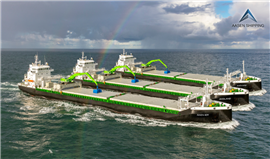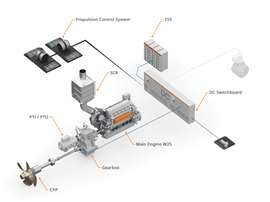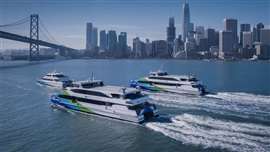Wärtsilä supports both hybrid and electric marine solutions
14 December 2023
Wärtsilä announced two separate agreements supporting sustainable operations in the maritime industry. In addition to supplying hybrid propulsion for three cargo vessels, the company will provide services to support a project to build the first zero-emission high-speed ferries in the U.S.
 The latest order represents the third hybrid propulsion solution provided for Aasen Shipping vessels. (Photo: Aasen Shipping)
The latest order represents the third hybrid propulsion solution provided for Aasen Shipping vessels. (Photo: Aasen Shipping)
Wärtsilä will supply an integrated hybrid propulsion solution for three new self-discharging cargo vessels being built at the Royal Bodewes shipyard in the Netherlands for Norwegian shipowner Aasen Shipping. The solution combines batteries with the Wärtsilä 25 medium-speed, modular four-stroke marine engine, which is available in cylinder configurations from 6 L to 9 L and with a power output from 1.7 to 3.4 MW.
“The combination of the highly efficient and flexible Wärtsilä 25 engine with batteries provides both optimized operations and environmental sustainability. The ships can use electrical battery power when in harbor and for low-load operations, and then switch to the main engines for transit,” said Stefan Nysjö, vice president of Power Supply, Wärtsilä Marine Power. In addition, both the engine and vessels will be capable of operation on sustainable fuels in the future.
 Wärtsilä’s integrated hybrid propulsion solution. (Photo: Wärtsilä)
Wärtsilä’s integrated hybrid propulsion solution. (Photo: Wärtsilä)
This is not the first time the company has developed such a solution for Aasen Shipping vessels. It delivered a similar hybrid propulsion system to Aasen for the Aasfoss and Aasfjell, which have been in operation for almost two years. This success was cited as a prime consideration in the award of this new order, which was booked in September 2023.
“We have been very satisfied with Wärtsilä’s support and close cooperation in helping us to achieve more efficient and cleaner cargo transport. This is important to us. Plus, the Wärtsilä engines are made ready for us to switch later to sustainable fuels, which will allow us to significantly further reduce carbon emissions in line with our fleet decarbonization aims,” said Torbjørn Torkelsen, CEO, Aasen Shipping.
The three 9500 DWT vessels will each operate with one six-cylinder Wärtsilä 25 main engine fitted with the company’s NOx reduction system, gearbox and controllable pitch propeller with shaft line and Pro-Touch bridge control system. They will also include the hybrid system with DC hub and 620-kWh battery capacity, the control system, as well as the battery, power and energy management systems.
The Wärtsilä equipment is scheduled for delivery to Royal Bodewes in December 2025 and in 2026.
Fully electric ferries for U.S.
The company also announced it has signed a strategic partnership agreement to provide its Fleet Electrification and Systems Integrator Services for a project to build the first zero-emission high-speed ferries in the United States. The fully electric vessels will be built for San Francisco’s Water Emergency Transportation Authority (WETA), the operator of the San Francisco Bay Ferry system. WETA is committed to accelerating zero-emission implementation ahead of and beyond compliance with new California Air Resources Board (CARB) regulations, and in order to continue to be a leader in the sector.
 Wärtsilä will provide its Fleet Electrification and Systems Integrator Services for a project to build the first zero-emission high-speed ferries in the U.S. (Photo: WETA)
Wärtsilä will provide its Fleet Electrification and Systems Integrator Services for a project to build the first zero-emission high-speed ferries in the U.S. (Photo: WETA)
The project, and several others Wärtsilä will work on under this partnership, are a part of the agency’s Rapid Electric Emission-Free (REEF) Ferry Program, a phased decarbonization of high-speed, high-capacity ferry service in the San Francisco Bay. Wärtsilä will work within the WETA project team to finalize vessel and charging system concepts, the company noted.
After completing the conceptual phase, WETA will move on to the initial construction phase of a multi-vessel program. This phase will involve the building of three smaller ferries with a capacity of approximately 150 passengers each and two larger ferries capable of carrying at least 300 passengers. In addition, the scope of this phase will encompass the inclusion of battery charging floats.
The construction of the first electric-powered vessel is slated to commence before the end of 2023, with commercial operations expected to launch in 2025.
STAY CONNECTED




Receive the information you need when you need it through our world-leading magazines, newsletters and daily briefings.
POWER SOURCING GUIDE
The trusted reference and buyer’s guide for 83 years
The original “desktop search engine,” guiding nearly 10,000 users in more than 90 countries it is the primary reference for specifications and details on all the components that go into engine systems.
Visit Now
CONNECT WITH THE TEAM










